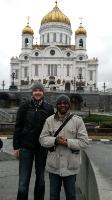
Mr Colin Mkhize, a 2nd year Chemistry Masters student under the supervision of Distinguished Prof Tebello Nyokong recently visited the Frumkin Institute of Physical Chemistry and Electrochemistry, Russian Academy of Sciences in Moscow, Russia.
This forms part of a research collaboration between the South Africa’s National Research Foundation (NRF) and the Russian Foundation for Basic Research. The principal researchers/investigators for above collaboration are Prof Tebello Nyokong from Rhodes University (South Africa) and Prof Aslan Yu. Tsivadze from the Frumkin Institute of Physical Chemistry and Electrochemistry, Russian Academy of Sciences (Russia).
Mr Mkhize commented the following about his trip:
“From the 26th of October to the 16th of November, I was privileged to spend some time in Russia thanks to the above research collaboration. This was a trip which I will never forget!
I was initially quite scared to go to Russia due to the recent political and economic issues which have arisen due to the Ukrainian conflict. However, this did not deter me. I set out on this my first international trip with much excitement. On arriving in Moscow, I was welcomed by Dr Alexander Martynov. He immediately made me feel welcome and helped me to obtain the currency I would need to live here, Rubles. Lucky for me, the Ruble is weaker than the Rand! I was taken to my accommodation in a suburb of Konkovo using the underground metro train system. I was really impressed by its efficiency and ease of use. Definitely something everyone should try once in their life.
On Tuesday the 28th, I was finally introduced to the lab at the institute. I was lucky enough to be the first person to work in the lab as it had recently been refurbished and had all new equipment. There were a few issues, but working in this lab was a chemist’s dream come true.
I was given the task of synthesizing two triple decker phthalocyanines (TDPc), using europium as the central metal. One TDPc was three octabutoxyPcs put together, and the other was an asymmetric Pc which had two diethylene glycol chains for attachment to quantum dots for the purpose of making novel optical limiting nanocomposites. At the end of my three weeks, we successfully synthesized the 1st compound, but ran out of time for the 2nd. This was alright, as we had proven that it can be made and it is undergoing further analysis in Moscow.
On a more social side, I was blessed to visit various sites of interest in Moscow including the Kremlin, St Basils Cathedral, the Red Square, the Cathedral of Christ the Saviour and other really cool places. The most beautiful was the Russian Museum of Fine Arts. I also got a chance to visit St Petersburg for a weekend. An absolutely amazing place, except for the horrendous weather!
I would like to thank Prof Nyokong for affording me this amazing opportunity to experience an international lab and to be immersed in a completely foreign culture and learn to truly appreciate the science we do here in South Africa. I learnt a lot of things; both chemical and personal. I would also like to thank my hosts, Dr Martynov, Prof Gorbunova, Prof Tshivadze and the whole of Lab 213 at the Frumkin institute for the amazing memories. I hope to one day again visit this amazing country.
The average temperature was a chilly 4°C with the occasional light snowfall or drizzle. Definitely a new experience for a South African! “
